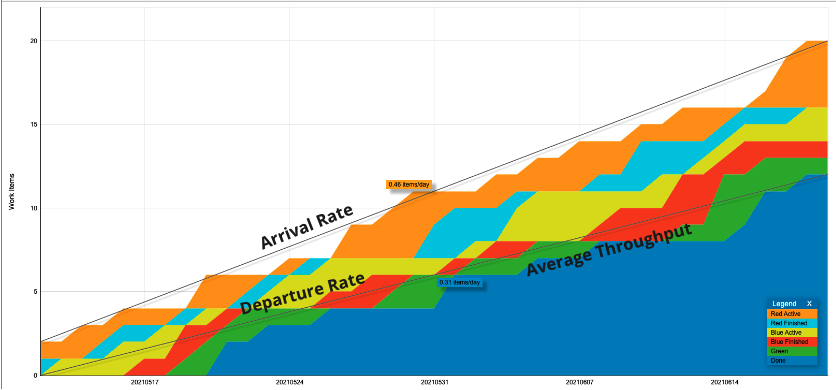In a previous post I introduced the four assumptions behind Little’s Law and the idea that they are critical to understanding and improving your system’s predictability. If you haven’t read that post I encourage you to go back to understand the background. As a reminder, the four assumptions are listed below.
Four Assumptions of Little’s Law
- The average arrival rate is equal to the average departure rate.
- All work entering the system will eventually depart the system.
- The average age of work remains constant, neither increasing nor decreasing.
- Consistent units are used to measure WIP, Cycle Time, and Throughput.
Today we will focus our discussion on the first assumption, that the average arrival rate is equal to the average departure rate.
The Average Arrival Rate of a Kanban system is equal to the number of work items that cross the Started point of the system over a period of time. Similarly, the Average Departure Rate of a system is equal to the number of work items that cross the Finished point of the system over a period of time. These rates can both be easily visualized on a Cumulative Flow Diagram as the slope of the upper and lower lines of the diagram:

When the average arrival rate is higher than the average departure rate, as in the picture above, the system can be thought of as accumulating Flow Debt. A system that is accumulating Flow Debt will often see an increase in variance of Cycle Times or Work Item Age due to effort being put towards starting new work rather than finishing old work. This system will also either see average cycle times increase or average throughput decrease. These changes in average cycle times or throughput may be significantly delayed due to work being ignored and sitting idle within your process. This is an occasion that monitoring in progress work item age as well as total work in progress is critical to understanding the effect of changes in your system.
On the other hand, a system where the average arrival rate is lower than the average departure rate could be thought of as paying off Flow Debt. This system will likely see the variance in Cycle Times and Work Item Age decrease over time although depending on the current age of work in progress it could see an initial spike in these measures. It is also likely to see either a decrease in average cycle times or an increase in average throughput. These changes are also likely to be delayed until after the system stabilizes to a point where average arrival rate and average departure rate match.
These rates not matching is a state that must exist when making any changes to the target amount of Work in Progress. If the Kanban system is in the process of reducing overall WIP then it will have an average arrival rater lower than the average departure rate. Depending on how drastic of a change is being made here the predictability of the system may plummet when this change is made. That doesn’t mean that making the change is a bad thing! But be aware of the impact on predictability when a change is being made here.
Click Here to read more about the second assumption of Little’s Law, that all work that enters the system will eventually depart the system.